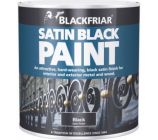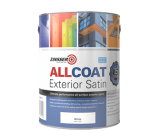
Metal Paint
Our specialist selection of metal paint can be applied to directly to the surface to add a layer of protection and to enhance its appearance. Most of the solutions have self-priming properties and can be applied directly to rust and can give up to 8 years protection. The quick drying formulas are available in satin and matt and they all guarantee excellent colour retention.
-

Blackfriar Satin Black Paint
From:£6.49(inc VAT)multiple sizes -

Zinsser AllCoat Exterior Satin Water Based (Tinted Colours)
From:£22.95(inc VAT)1711 colours multiple sizes
Frequently asked questions about metal paint
How to paint metal
Painting metal requires the same level of preparation and steps as painting other surfaces. Follow the below steps for a smooth metal paint job:
- Thoroughly inspect the metal surface for cracks, peeling or chipped paint. For extra safety, wear a dust mask as you remove these surface imperfections with a wire brush. If the imperfections do not budge, consider using Hammerite No1 Rust Beater or HG Rust Remover for easy removal.
- Sand the metal with a sanding block or square of sandpaper. Once you have proficiently sanded the metal surface, wipe it down with a damp cloth to remove all dust.
- Apply a metal paint primer and allow to completely dry. All of our metal paints have individual datasheets with recommendations for the best metal primer to use for the specific formulation.
- Use a brush or roller to apply several thin coats of your chosen metal paint. Allow the paint to dry for a few hours between coats.
- Allow the paint to dry overnight or by the manufacturer’s recommended drying times.
How to remove paint from metal
Follow the below steps to safely and effectively remove paint from metal surfaces
- Prepare the work area and yourself for the task. Cover the ground with drop cloths, old newspapers or flattened cardboard boxes. Wear rubber gloves, protective glasses, long-sleeved and full-length clothing to cover your skin completely. Ensure that the area you are working in is fully ventilated or wear a respiratory mask.
- Apply your chosen paint stripper or remover to the metal surface using a disposable paintbrush and allow it to set according to manufacturer’s instructions. You should be able to see the paint bubble on the metal surface.
- After giving the paint stripper or remover its allocated setting time, use a paint scraper to remove the bubbled paint from the metal surface. Repeat steps 2 and 3 as needed until the surface is paint-free.
- Wipe the surface with white spirit on a cloth to remove leftover paint and any remaining chemical residue.
- Rinse the metal surface with water to completely remove all chemical traces and wipe down with a clean, dry cloth.
How to paint rusty metal
We would always recommend, especially for trade jobs, to remove any rust from a metal surface prior to applying paint. However, if you are completing a quick-fix DIY project in your own home, our range of Rust-Oleum Aerosol paints are a great option to not disrupt the underlying metal surface.


